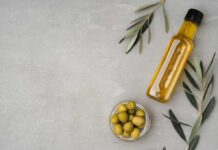
It sounds kind of crazy. “Powerful sesame seed” certainly seems like an oxymoron, but this tiny seed offers so much more than a distinct nutty flavor. It is a powerhouse of organic minerals, especially calcium, and is an alkaline food that supports bone and general health. That’s exactly why Sesame Seeds made it to the list of ‘Foundation Foods’ in the Osteoporosis Reversal Program.
Sesame seeds add texture to baked goods, a nutty flavor to sushi rolls, stir-fries and salads, and ground sesame seeds are used to make delicious and nutritious spreads like tahini, hummus, and sesame butter. Plus, I don’t think I’ve ever met anyone who doesn’t like them.
The Hard Facts about Sesame Seeds
Sesame seeds are full of calcium, magnesium, copper, vitamin B1, zinc and dietary fiber. They offer the most nutritional value when the entire seed is used (un-hulled).
Whole sesame seeds contain about 88 mg of calcium per tablespoon of seeds. Just a quarter cup of natural sesame seeds provides more calcium than a whole cup of milk. A quarter cup of raw natural sesame seeds has 351 mg of calcium while one cup of non-fat milk has 316.3 mg, and one cup of whole milk has only 291 mg of calcium. Plus, they are alkaline whereas milk is acidic.
Sesame seeds are also rich in zinc, another mineral that has a positive effect on bone mineral density. A study published in the American Journal of Clinical Nutrition found a correlation between low dietary intake of zinc and osteoporosis at the hip and spine.1
Copper, better known for its anti-inflammatory ability shown to reduce some of the pain and swelling of rheumatoid arthritis, is also a supporter of bone and blood vessel health.
More than Just Bone Health
While calcium is vital to bone health, it also can help with migraines2 and provide relief for PMS.3
These multi-tasking seeds are also rich in sesamin and sesamolin, fibers called lignans that can lower cholesterol and help prevent high blood pressure.4
As if you need another reason to make sesame seeds a pantry staple, they are a great source of phytosterols, plant sterols that have also been shown to lower blood cholesterol5 and improve heart health.6
Processing and Cooking
Keep in mind, how a food is processed and cooked changes its nutritional value. For example, the calcium level decreases about 60 percent when the hulls are removed from the sesame seed; however, the form of calcium in the hulls is calcium oxalate, a less absorbable form of calcium.
The actual harm of removing the hull is debatable. When the seed is crushed, as in tahini or sesame butter, its nutrients are more easily digested. When left whole, the seeds do not break down as well during digestion.
Toasting or roasting sesame seeds alter their nutritional value. Studies show that the calcium levels are slightly higher when the seeds are toasted. For example, one could get 27 percent of their daily value of calcium in one ounce of whole sesame seeds, but 28 percent if the seeds are roasted. Likewise, one ounce of hulled raw kernels will get give you 2 percent of your daily value of calcium. That number doubles when the kernels are toasted.
Small Seeds, Big Taste
Okay, you get it, they’re healthy! But there’s more, because sesame seeds are also delicious. If you think that a bakery roll is the only way to serve sesame, you are missing out. Toasted or raw seeds (whole or hulled) can be added to steamed broccoli (a veggie rich in calcium), stir-fried green beans, put on top of salads and in dressings, sprinkled on baked goods, and mashed and ground into condiments and spreads. Try using sesame seeds in place of acidifying breadcrumbs.
During my travels to the Middle East, I learned many uses of sesame, both culinary and medicinal. One of my go-to snacks to this day is tahini. It’s a wonderful paste made of sesame seeds that you can use in spreads, dressings, sauces, or all by itself on crackers and toast. You can even use it as a dip with fruits and veggies.
To get started with sesame seeds, here’s my favorite and simple tahini recipe. Enjoy!
Treasure Trove Tahini
Prep Time: 5 minutes
Cook Time: 10 minutes
Total Time: 15 minutes
Yield: 4 cups
Ingredients:
- 5 cups sesame seeds (hulled)
- 1½ cups olive oil
Preparation:
Preheat oven to 350. Toast sesame seeds for 5-10 minutes, tossing the seeds frequently with a spatula. Do not allow to brown. Cool for 20 minutes. Pour sesame seeds into a food processor and add oil. Blend for 2 minutes. Check for consistency. The goal is a thick, yet pourable texture. Add more oil and blend until desired consistency.
Storing Tahini:
Tahini should be stored in the refrigerator in a tightly closed container. It will keep for up to 3 months.
References:
- Hyun T., Barrett-Connor E., Milne D. ; “Zinc intakes and plasma concentrations in men with osteoporosis: the Rancho Bernardo Study”. American Journal of Clinical Nutrition, Vol. 80, No. 3, 715-721. September 2004.
- Thys-Jacobs S, “Alleviation of Migraines with Therapeutic Vitamin D and Calcium”. Headache: the Journal of Head and Face Pain. Volume 34 Issue 10, 590 – 592. May 2005.
- Thys-Jacobs S, “Micronutrients and the Premenstrual Syndrome: The Case for Calcium”. Journal of the American College of Nutrition. Vol. 19, No. 2, 220-227. 2000.
- Adlercreutz H. “Lignans and human health”. Critical Reviews in Clinical Laboratory Sciences. Vol 44, 483-525, 2007.
- Ostlund, R. E., Jr, Racette, S. B., and Stenson, W. F. “Inhibition of cholesterol absorption by phytosterol-replete wheat germ compared with phytosterol-depleted wheat germ.” American Journal of Clinical Nutrition. Vol. 77, No. 6, 1385 – 1589. 2003.
- Kritchevsky, D. Phytosterols: Dietary fiber in Health and Disease. (Eds.) Kristchevsky and Bonfield., Plenum Press, New York, 427: 235 – 242. 1997.
Important Notice: This article was originally published at https://saveourbones.com by Vivian Goldschmidt, MA where all credits are due.
Disclaimer
The watching, interacting, and participation of any kind with anything on this page does not constitute or initiate a doctor-patient relationship with Dr. Farrah®. None of the statements here have been evaluated by the Food and Drug Administration (FDA). The products of Dr. Farrah® are not intended to diagnose, treat, cure, or prevent any disease. The information being provided should only be considered for education and entertainment purposes only. If you feel that anything you see or hear may be of value to you on this page or on any other medium of any kind associated with, showing, or quoting anything relating to Dr. Farrah® in any way at any time, you are encouraged to and agree to consult with a licensed healthcare professional in your area to discuss it. If you feel that you’re having a healthcare emergency, seek medical attention immediately. The views expressed here are simply either the views and opinions of Dr. Farrah® or others appearing and are protected under the first amendment.
Dr. Farrah® is a highly experienced Licensed Medical Doctor certified in evidence-based clinical nutrition, not some enthusiast, formulator, or medium promoting the wild and unrestrained use of nutrition products for health issues without clinical experience and scientific evidence of therapeutic benefit. Dr. Farrah® has personally and keenly studied everything she recommends, and more importantly, she’s closely observed the reactions and results in a clinical setting countless times over the course of her career involving the treatment of over 150,000 patients.
Dr. Farrah® promotes evidence-based natural approaches to health, which means integrating her individual scientific and clinical expertise with the best available external clinical evidence from systematic research. By individual clinical expertise, I refer to the proficiency and judgment that individual clinicians acquire through clinical experience and clinical practice.
Dr. Farrah® does not make any representation or warranties with respect to the accuracy, applicability, fitness, or completeness of any multimedia content provided. Dr. Farrah® does not warrant the performance, effectiveness, or applicability of any sites listed, linked, or referenced to, in, or by any multimedia content.
To be clear, the multimedia content is not intended to be a substitute for professional medical advice, diagnosis, or treatment. Always seek the advice of your physician or other qualified health providers with any questions you may have regarding a medical condition. Never disregard professional medical advice or delay in seeking it because of something you have read or seen in any website, video, image, or media of any kind. Dr. Farrah® hereby disclaims any and all liability to any party for any direct, indirect, implied, punitive, special, incidental, or other consequential damages arising directly or indirectly from any use of the content, which is provided as is, and without warranties.








